Resumen visual de la Conferencia WWW2010Visual analysis of WWW2010 Conference
Del 26 al 30 de abril se celebró la conferencia WWW2010. No pude asistir pero recogí los tweets marcados con el hashtag #www2010 desde el 31 de marzo hasta el 3 de mayo y como una imagen vale más que mil palabras he realizado un resumen visual de la Conferencia.
(Al pulsar en la imagen se mostrará en su tamaño real)
Datos de interés
- Usuarios: se han recogido 3093 tweets en los que se han detectado 9001,24 tweets/usuario. el 20% de los usuarios han escrito el 71,35% de los tweets. Los 10 usuarios más activos han sido: @futureweb2010 (125), @LaTerribleLiz (119), @BoraZ ( 96), @fabien_gandon ( 88), @smalljones (67), @tommyh @olgag (57), @apisanty (47), @karenchurch.
- Urls: se han encontrado 1.112 urls, de las cuales 549 eran distintas, con un índice de repetición de 2,03. Se han detectado 845 urls acortadas, lo que supone un 76%. El servicio cortador más extendido es bit.ly con un 65,9%.
- Tendencias: Se detecta un interés creciente en Twitter. En la conferencia WWW2009 se utilizó como herramienta de comunicación y ahora se estudia como fenómeno emergente. Se encuentra presente en el top ten de las urls con más RTs y clicks.
- RT vs. Clicks: No se ha encontrado una correlación entre el número de retransmisiones de los tweets y el numero de clicks alcanzados, como se puede ver en la siguiente figura:
Metodología
- Se han utilizado herramientas propia para extraer la información (programadas en Python)
- Se ha utilizado el API de bit.ly con la librería Python-bitly de yoav.aviram para obtener los clicks y las urls reales y el número de clicks
- Las visualizaciones se han realizado con many eyes
DataSet:
Post relacionados:
The WWW2010 Conference took place on April 26-30. I couldn’t attend it but I collected all the tweets with the hashtag #www2010 from March 31 to May 3. As an image is worth more than a thousand words I made a visual analysis of the Conference from this data.
(Click on the image to see it larger)
| Who were the most active Twitters?
|
What were the most used words?
|
| What were the most cited sites?
|
What were the shorten urls services used?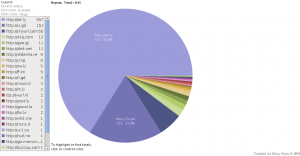
|
| What were the most retwittered URL’s? Twitter Papers at the WWW 2010 Conference
(22) WWW2010 Twitter Roomstreams (19) RTP Meetup (15) Futureweb (schedule) (13) What is Twitter, a social network or a news media? (12) Elon University/Pew Intenet Project (Futureweb) (11) Durham, a Tobacco Town, Turns to Local Food (10) Fresh Direction: A Farm-to-Table Restaurant (10) |
What were the most clicked URL’s? (1) xkcd (2.870)
Facebook’s Eroding Privacy Policy: A Timeline (1696) Truly W3C Community building at WWW2010 (Part 1) (1577) Web 2.0 Suicide machine (1248) Tim Berners-Lee on the next Web (1085) Privacy and Publicity in the Context of Big Data (1011) Why Twitter Is the Future of News (996) What is Twitter, a Social Network or a News Media? (739) Open Graph protocol (359) |
| How often did users twitter by day?
|
How often did users twitter by the hour?
|
Highlighted data:
- Users: 3,093 tweets were written by 900 different users, with an average of 1.24 tweets / user. 71.35% of tweets were written by 20% of users (Paretos’s Law). The most actives users were: @futureweb2010 (125), @LaTerribleLiz (119), @BoraZ ( 96), @fabien_gandon ( 88), @smalljones (67), @tommyh @olgag (57), @apisanty (47), @karenchurch.
- URLs: 1,112 urls were found, 549 of them were different. There were 845 (76%) shorted URLs. Bit.ly was the most shorten url service used with a share of 65.9%.
- Trends: there is a growing interest in Twitter, it is present in most RTs and clicked URLs. However, it maybe due to people who use twitter being more interested in Twitter.
- RT vs. Clicks: There is not a correlation between RTs and Clicks, as can be seen in the image:
Methology
- Own tools were used to extract data
- The bit.ly API and the Python-bitly library were used to get the number of clicks for each URL.
- Many eyes web service was used to data visualize
DataSet:
(1) This ranking is only for URLs shorted with bit.ly. Others URLs couldn’t be measured

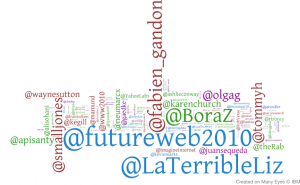
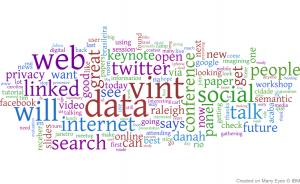
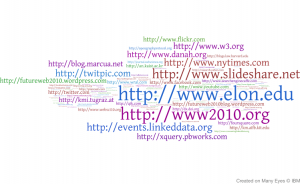
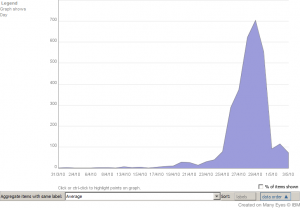
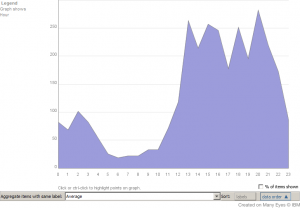
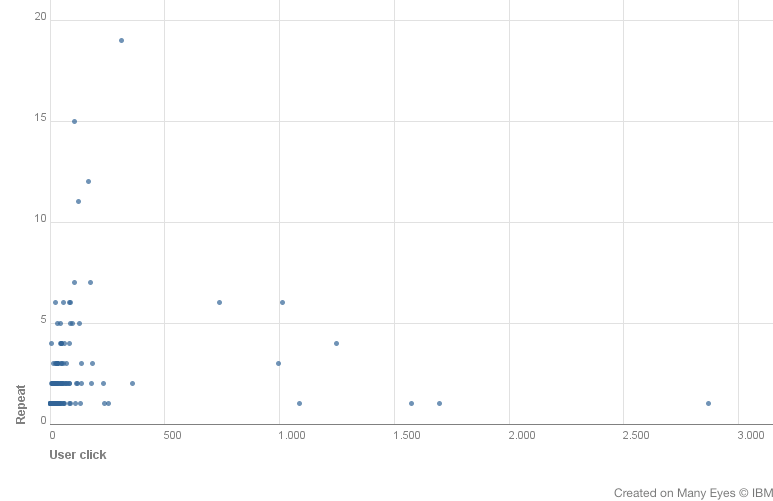
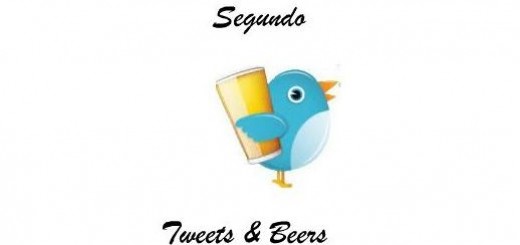
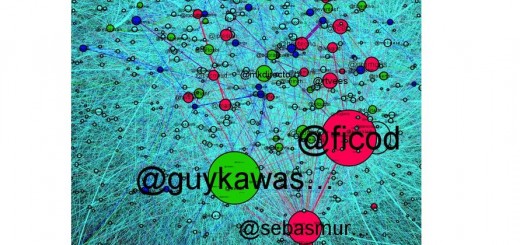
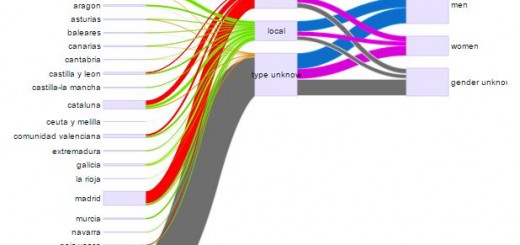
Alex,
Thanks!!
Very interesting your paper, I’m going to read it in depth.
Interesting !
You may also have a look at http://journal.webscience.org/314/2/websci10_submission_79.pdf for an analysis of the use of Twitter on other conferences